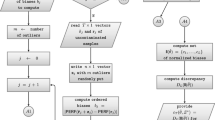Abstract
Sharpe ratio is one of the widely used measures in the financial literature to compare two or more investment strategies. Since it is a ratio of the excess expected return of a portfolio to its standard deviation of returns, it is not robust against the presence of outliers. In this paper we propose a modification of the Sharpe ratio which is based on robust measures of location and scale. We investigate the properties of this proposed ratio under six alternative return distributions. It is seen that the modified Sharpe ratio performs better than the original Sharpe ratio in the presence of outliers. A real life stock market return data set is analyzed and the comparative performances of the two ratios are studied. The results indicate that modified Sharpe ratio may be a better measure for comparing different investment strategies. When downside risk is the only concern of the investors a modification of the Sharpe ratio known as Sortino ratio is often used. It is shown that the Sortino ratio is not robust and we propose a modified version of the same which is robust.



Similar content being viewed by others
References
Bao, Y. and Ullah, A. (2006). Moments of the estimated Sharpe ratio when the observations are not IID. Financ. Res. Lett. 3, 49–56.
Chaudhry, A. and Johnson, H.L. (2008). The efficacy of the Sortino ratio and other benchmarked performance measures under skewed return distributions. Aust. J. Manag.32, Special Issue.
Cramer, H. (1946). Mathematical Methods of Statistics. Asia Publishing House.
Falk, M. (1997). Asymptotic independence of median and MAD. Statist. Probab. Lett. 34, 341–345.
Hampel, F.R. (1974). The influence curve and its role in robust estimation. J. Am. Stat. Assoc. 69, 383–393.
Hampel, F.R., Ronchetti, E.M., Rousseeuw, P.J. and Stahel, W.A. (1986). Robust Statistics: the Approach Based on Influence Functions. Wiley, New York.
Huber, P.J. (1964). Robust estimation of a location parameter. Ann. Math. Stat.35, 73–101.
Huber, P.J. (1965). A robust version of probability ratio test. Ann. Math. Stat. 36, 1753–1758.
Huber, P.J. (1968). Robust confidence limits. Z.Wahrsch. verw.Geb. 10, 269–278.
Huber, P.J. (1981). Robust Statistics. Wiley, New York.
Jobson, J.D. and Korkie, B.M. (1981). Performance hypothesis testing with the Sharpe and Treynor measures. J. Financ. 36, 889–908.
Knight, J. and Satchell, S. (2005). A re-examination of Sharpe’s ratio for log-normal prices. Applied Mathematical Finance 12, 1, 87–100.
Ledoit, O. and Wolf, M. (2008). Robust performance hypothesis testing with the Sharpe ratio. J. Empir. Financ. 15, 850–859.
Lo, A.W. (2002). The statistics of Sharpe ratios. Financ. Anal. J. 58, 4, 36–52.
Marona, R.A., Martin, R.D. and Yohai, V.J. (2006). Robust Statistics: Theory and Methods. Wiley, New York.
Marsaglia, G. (1965). Ratios of normal variables and ratios of sums of uniform variables. J. Am. Stat. Assoc. 60, 193–204.
Marsagila, G. (2006). Ratios of normal variables. J. Stat. Softw. 16, 4.
Miller, R.E. and Gehr, K.A. (1978). Sample size bias and sharpe’s performance measure: a note. J. Financ. Quant. Anal. 13, 943–946.
Nielsen, L.T. and Vassalou, M. (2004). Sharpe ratios and alphas in continuous time. J. Financ. Quant. Anal. 39, 1, 103–114.
Opdyke, J.D. (2007). Comparing Sharpe Ratios: So Where are the p-values?. J. Asset Manag. 8.
Pinar, M.C. (2016). On robust mean-variance portfolios. Optimization 65, 1039–1048.
Perold, A.F. (2004). The capital asset pricing model. J. Econ. Perspect. 8, 3, 3–24.
Rousseeuw, P.J. (1981). A new infinitesimal approach to robust estimation. Zeitschrift fuer Wahrscheinlichkeit und Verwandte Gebiete. 56, 127–132.
Roy, A.D. (1952). Safety first and the holdings of assets. Econometrika 20, 3, 431–449.
Serfling, R.J. (2002). Approximation Theorems of Mathematical Statistics. Wiley, New York.
Sharpe, W.F. (1966). Mutual funds performance. Journal of Business (January), 119–138.
Sortino, F.A. and Van der Meer, R. (1991). Downside risk. The Journal of Portfolio Management Summer, 27–31.
Staudte, R.G. and Sheather, S.J. (1990). Robust Estimation and Tests. Wiley, New York.
Tukey, J.W. (1960). A Survey of Sampling from Contaminated Distributions. In: Contributions to Probability and Statistics: Essays in Honor of Harold Hotelling, (I. Olkin, S. G. Ghurye, W. Hoeffding, W. G. Madow and H. B. Mann, eds.) Stanford University Press, p. 448–485.
Wilcox, R.R. (2012). Introduction to Robust Estimation and Hypothesis Testing. Elsevier, Amsterdam.
Acknowledgments
The authors express gratitude to the anonymous referees for their valuable comments which has led to substantial improvement of the article.
Author information
Authors and Affiliations
Corresponding author
Additional information
Publisher’s Note
Springer Nature remains neutral with regard to jurisdictional claims in published maps and institutional affiliations.
Rights and permissions
About this article
Cite this article
K.C, M., Laha, A.K. A Robust Sharpe Ratio. Sankhya B 83, 444–465 (2021). https://doi.org/10.1007/s13571-019-00204-y
Received:
Published:
Issue Date:
DOI: https://doi.org/10.1007/s13571-019-00204-y




